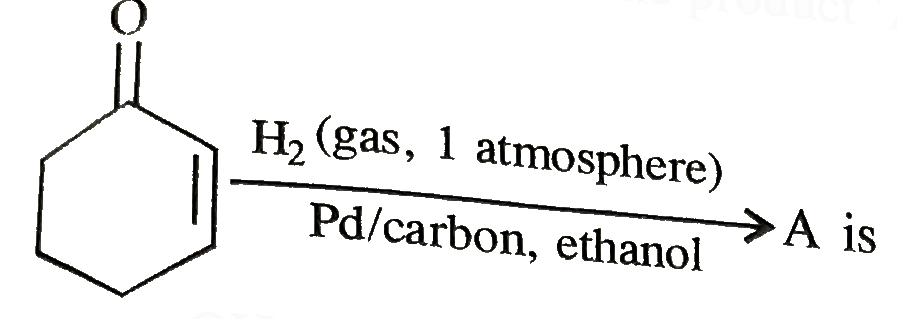If the starting material for the manufacture of silicone is RSiCl3, write the structure of the product formed.
The correct Answer is:A, B, C, D
To solve the problem of determining the structure of the product formed from the starting material RSiCl3, we can follow these steps:
Step 1: Identify the Starting Material
The starting material is \( RSiCl_3 \), where \( R \) represents an organic group (which can be an alkyl or aryl group) and \( SiCl_3 \) indicates that silicon is bonded to three chlorine atoms.
Step 2: Reaction with Water
When \( RSiCl_3 \) reacts with water (\( H_2O \)), a hydrolysis reaction occurs. The chlorine atoms are replaced by hydroxyl groups (\( OH \)). The reaction can be represented as follows:
\(
RSiCl_3 + 3 H_2O \rightarrow RSi(OH)_3 + 3 HCl
\)
This means that the product formed after hydrolysis is \( RSi(OH)_3 \), which is a silanol.
Step 3: Structure of the Silanol
The structure of the silanol \( RSi(OH)_3 \) can be depicted as follows:
OH|R−Si−OH|OH
Step 4: Polymerization
The silanol \( RSi(OH)_3 \) can undergo condensation reactions, leading to polymerization. During this process, water is eliminated, and siloxane bonds (\( Si-O-Si \)) are formed. The general structure of the polymer can be represented as:
\(
\text{(RSi-O)}_n
\)
Where \( n \) indicates the number of repeating units. The polymer can be depicted as follows:
RRR Si−O−Si−O−Si−O−... /RRR
Final Product Structure
The final product is a silicone polymer, which can be represented as:
RRR Si−O−Si−O−Si−O−... /RRR
This structure shows the repeating units of silicon and oxygen, with organic groups \( R \) attached to the silicon atoms.
Summary
The product formed from the starting material \( RSiCl_3 \) after hydrolysis and polymerization is a silicone polymer with a structure that consists of alternating silicon and oxygen atoms, with organic groups attached to the silicon.
---
The starting material is \( RSiCl_3 \), where \( R \) represents an organic group (which can be an alkyl or aryl group) and \( SiCl_3 \) indicates that silicon is bonded to three chlorine atoms.
When \( RSiCl_3 \) reacts with water (\( H_2O \)), a hydrolysis reaction occurs. The chlorine atoms are replaced by hydroxyl groups (\( OH \)). The reaction can be represented as follows:
RSiCl_3 + 3 H_2O \rightarrow RSi(OH)_3 + 3 HCl
\)
The structure of the silanol \( RSi(OH)_3 \) can be depicted as follows:
The silanol \( RSi(OH)_3 \) can undergo condensation reactions, leading to polymerization. During this process, water is eliminated, and siloxane bonds (\( Si-O-Si \)) are formed. The general structure of the polymer can be represented as:
\text{(RSi-O)}_n
\)
The final product is a silicone polymer, which can be represented as:
The product formed from the starting material \( RSiCl_3 \) after hydrolysis and polymerization is a silicone polymer with a structure that consists of alternating silicon and oxygen atoms, with organic groups attached to the silicon.
Topper's Solved these Questions
- P-BLOCK ELEMENT (BORON AND CARBON FAMILY)BOOK - RESONANCE ENGLISHCHAPTER - P-BLOCK ELEMENT (BORON AND CARBON FAMILY)EXERCISE - Exercise-1 Part-I : SUBJECTIVE QUESTIONS Section (H) :
1 Videos
- P-BLOCK ELEMENT (BORON AND CARBON FAMILY)BOOK - RESONANCE ENGLISHCHAPTER - P-BLOCK ELEMENT (BORON AND CARBON FAMILY)EXERCISE - Exercise-1 Part-II : ONLY ONE OPTION CORRECT TYPE Section (A) : Occurance, physical properties & Allotropy
10 Videos
- P-BLOCK ELEMENT (BORON AND CARBON FAMILY)BOOK - RESONANCE ENGLISHCHAPTER - P-BLOCK ELEMENT (BORON AND CARBON FAMILY)EXERCISE - Exercise-1 Part-I : SUBJECTIVE QUESTIONS Section (G) : Halides, Alums & Other metal salts
4 Videos
- P BLOCK ELEMENTSBOOK - RESONANCE ENGLISHCHAPTER - P BLOCK ELEMENTSEXERCISE - PART -II
23 Videos
- P-BLOCK ELEMENTS (HALOGEN & NOBLE GASES)BOOK - RESONANCE ENGLISHCHAPTER - P-BLOCK ELEMENTS (HALOGEN & NOBLE GASES)EXERCISE - APSP PART-3
22 Videos
Similar Questions
If the starting material for the manufacture of silicones is RSiCl3, write the structure of the product formed.
View SolutionWrite the structure of 3-pentanone.
View SolutionWrite the structure of 3-methyl butanal.
View SolutionWrite the structure of 3-Hydroxybutanal
View SolutionWrite the structure of 3-oxopentanal.
View SolutionWrite the structure of 3-oxopentanal.
View SolutionWrite the structure of 3-oxopentanal.
View SolutionStatement-1: R2SiCl2 is the starting material for linear polymer of silicone.
Statement-2: R2SiCl2 is the starting material for 3-D polymer of silicone.
Statement-3: R3SiCl is the starging material for 3-D polymerr of silicone.
View SolutionThe starting material for the manufacture of polyvinyl chloride is obtained by reacting HCl with .........
View SolutionThe correct structure of the product 'A' formed in the reaction

View Solution
